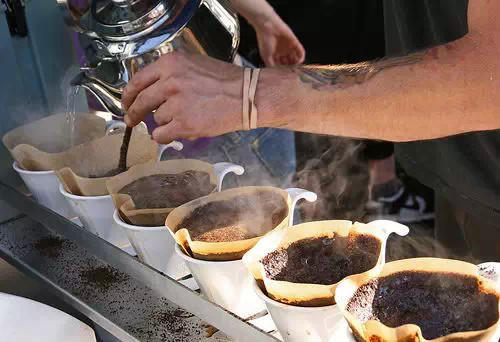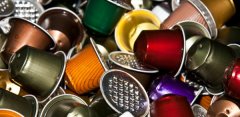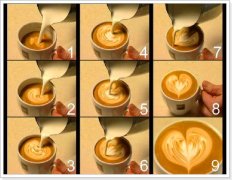Basic principles of coffee extraction: master the six basic conditions for extracting coffee

Professional coffee knowledge exchange more coffee bean information please follow the coffee workshop (Wechat official account cafe_style)
Espresso Coffee extraction detailed steps Italian concentration common sense
1. The ratio of coffee to water:
To put it simply, in the same 150cc cup, the higher the coffee content, the stronger the flavor, while the more water, the lighter the taste. But where is the ideal extraction we need? It depends on our purpose. Like ordinary drip coffee, we want a glycolic and refreshing taste, so we use a lower coffee-to-water ratio, while espresso aims to extract coffee concentrated like syrup in a short time, so use a higher coffee-to-water ratio. In the case of a cup of coffee, we expect that the weight of coffee released into the water is about 18% of coffee's weight. It can also be said that the exchange rate of coffee and water, we expect to fall between 18 murmurs 22%. To grasp this standard, it is usually recommended that the ratio of coffee to water is 1:19. Of course, this number is quite flexible. We often adjust the ratio of coffee to water according to individual taste, water temperature, grinding degree and roasting degree, and find out the most appropriate and suitable ratio of coffee to water after many fine-tuning.
two。 Grinding thickness and extraction time:
We can observe that when we go to the stream to play in the water, it is not easy to soak a pile of pebbles when the water is spilled on the pebbles; on the contrary, when we go to the seaside to play in the water, some water can wet a pool of sand. When we apply this physical phenomenon to coffee, it is not difficult to imagine how important the degree of grinding is to coffee extraction. Coarser grinding takes a long time to soak to release the taste of coffee into the water, extracted by soaking, such as French pressure, Syphon is ideal for coarse ground coffee, because the contact surface between coffee and water is small, so let the water pass too quickly, it is difficult for coffee to have proper contact time with water to dissolve the taste into the water. On the other hand, the use of finely ground coffee will save time for coffee to come into contact with water. If the way of soaking is used, there will be excessive extraction. So we usually use a method that allows water to quickly touch the coffee and flow out quickly. Such as hand flushing or concentrated extraction. As for the grinding degree, how much should be adjusted? Because everyone uses different equipment, it is not fair to say which bean grinder or coffee machine is standard. It is recommended to adjust the thickness according to the extraction method and personal taste. After all, what everyone likes is different, so many exceptions will happen. It is like the Turkish method of cooking very finely ground coffee and a small amount of water on the fire, which is very different from the principle we have mentioned above, but we cannot reject the Turkish method of extraction because of this. After all, Turkish coffee has a beautiful side of Turkish coffee, just from a different point of view.
3. Proper extraction operation
According to the situation of coffee, we often use the following three techniques to adjust 1 to estimate the degree of grinding of coffee and the time of coffee in contact with water. As mentioned in the previous paragraph, rough grinding and fine grinding are suitable for cooking, and a little carelessness may lead to underextraction or overextraction. two。 The temperature of water. The higher temperature will shorten the extraction time, while at lower temperature we need to prolong the extraction time to obtain the ideal extraction degree. In terms of water temperature, we usually recommend that it fall between 94 degrees Celsius, in other words, boiling water is not an ideal choice for coffee extraction, because too high temperature will seriously shorten the extraction time, so excessive extraction often occurs, resulting in reduced aroma, poor flavor, and heavy taste due to excessive extraction. 3. Turbulence. In order to soak the coffee evenly, we often wet the coffee first, let the water flow through the coffee once, tidy up the contact surface between the coffee and water, and then formally extract it. We often use this technique when using hand pots, and some people call it "steaming". Similarly, when we use syphon, we also use this technique to smooth the interface between water and coffee to achieve the purpose of balanced extraction.
4. Ideal extraction method
According to the way the equipment is used, we are roughly divided into six different extraction methods:
i. Immersion: nothing is more representative than French pressure. Let the coffee soak in hot water for a period of time and then filter out.
ii. Cooking method: people who often watch westerns may have seen the heroine put coffee and water in a pot and cook it directly on the stove in Once Upom A Time In The West. Use slow heating and hot convection extraction in water to extract coffee
iii. Osmosis: the principle of mocha pot belongs to osmosis. Heat the hot water vapor into the metal tube, spread the coffee evenly in the filter, and finally the extracted coffee liquid flows out from the outlet of the pot.
iv. Drip filter: both hand-made and American coffee machines belong to this method, which drips hot water into the coffee and uses the physical nature of the water to extract the coffee from top to bottom.
v. Vacuum filtration: Syphon is the most representative tool for this kind of extraction. Using the siphon principle, the hot water is sucked into the upper pot from the lower pot, the extraction is completed, and then the lower pot is cooled, and then the water is sucked back into the lower pot.
vi. Pressure injection: Espresso is representative of this method. Using the pressure generated by the machine, let the water pour into the coffee instantly to extract the most essential part of the coffee.
Each of the above methods has its advantages and disadvantages. There is no perfect extraction method in the world, but as long as we grasp the principles of extraction and correct operation, we can avoid a lot of mistakes.
5. Good water quality
Remember the weight ratio of the water in the above cup of coffee? It's 1:19 with coffee. After deducting the solid part, water accounts for 98% of a cup of coffee! So we can say that the quality of water affects 98% of coffee. In addition to pure water, there are many kinds of minerals and, of course, some microbes in the water we use. Because coffee is very sensitive, too much or too little minerals will affect the taste of coffee. If there are too many minerals, it can even damage our equipment (especially Espresso Machine, calcium is the killer of machines). Therefore, it is very important for us to soften and filter water quality. Taiwan's tap water quality is not good, high chlorine content, biological impurities (microorganisms, organic matter, bacteria.) It is not low, although it is much better than India, but we all know that the quality of raw water is poor can not be drunk, drink directly boiled water, the taste is not very good. Of course, this kind of water-extracted coffee will not taste any better. But if it is filtered and softened, the situation can be greatly improved.
6. Appropriate filter media
After the re-extraction, we must remove the turnips through the filter and filter out the extracted coffee to get a cup of coffee with better taste. According to the material, we have the following four different filter media.
a. Metal filter, filter cup: take out the Portfilter of Espresso, and we can all find a small metal basin covered with small holes. We usually extract coffee in this small basin, and the extracted coffee liquid leaks out of the small hole. The biggest advantage of this method is that the filter cup is a permanent commodity, normal use is not easy to damage, and the disadvantage is the need for careful cleaning, otherwise the residue and oil stains will affect the next use.
b. Mesh filter: when you turn on the American coffee machine, the factory usually gives away a nylon mesh filter. We use nylon or metal woven mesh to filter the coffee. The advantage of this kind of filtration is that the outlet of the water is many and dense, which can make the water rush through the coffee quickly and flow out smoothly, but the disadvantage is that it is easy to bring out the fine powder of coffee, resulting in the turbidity of the coffee extract.
c. Filter cloth: just like traditional Chinese medicine brine bag and tofu cloth, the pores woven by cloth fibers are more and denser than metal mesh or nylon mesh, and the cloth is somewhat absorbent and can wrap some water. Let the water flow out of the coffee too fast to avoid over-extraction. But because the furnishings are easy to absorb the taste, they have to be washed once, and boiled in hot water to remove the residual taste of most of the last batch of coffee. And the filter cloth is not a permanent commodity and will be replaced over a period of time.
d. Filter paper: I believe everyone has the experience of putting filter paper in coffee machine, whether it is American bucket or funnel-shaped, filter paper can be said to be the most efficient and convenient filtering method (no wonder American coffee machines are used in offices). However, there are many disadvantages of filter paper, not only not environmentally friendly, bleached filter paper flavor also affects the quality of extracted coffee. Therefore, most boutique coffee is not recommended to use filter paper as a filter medium.
As long as you master the above six basic conditions, I believe everyone can use the simple equipment on hand to make a quality extraction!
.
Important Notice :
前街咖啡 FrontStreet Coffee has moved to new addredd:
FrontStreet Coffee Address: 315,Donghua East Road,GuangZhou
Tel:020 38364473
- Prev

What is the use of the hole behind the Nespresso aluminum capsule? Explanation on the principle of capsule Coffee extraction
Professional coffee knowledge exchange more coffee bean information please follow the coffee workshop (Wechat official account cafe_style) Nespresso capsule coffee in the end how to extract? I believe many people have the same question. Today, I would like to share with you, see the picture below? Many people don't know the head and tail of the capsule coffee mug. We say that the mouth (head) of the capsule is aluminum.
- Next

Coffee flower art Latte Art of Coffee espresso latte how to pull flowers
Professional coffee knowledge exchange more coffee bean information please follow the coffee workshop (Wechat official account cafe_style) latte coffee latte how many kinds of pull flowers? The simplest pattern of coffee flowers-people who like to drink coffee all like to see the art graphics on the top of the coffee. In fact, this art is called pull flowers, which can drink mellow coffee and enjoy lovely totems at the same time.
Related
- What is the meaning of lactic acid fermentation with coffee bean treatment?
- How to judge the state of foam by sound?
- How does the latte pull out the unicorn pattern? Come to get for a little trick to improve the flower pull!
- Will flower pulling affect the taste of the latte?
- Do you know the history of coffee?
- The difference between honey treatment and sun washing what is raisin honey treatment?
- What kind of milk can a novice use to make coffee foam to keep the foam longer? The correct method and skills of milking tutorial sharing
- Why do washed coffee beans taste sour? Flavor characteristics of washed Coffee
- Introduction to the skill of how to practice the size and height of water injection around the circle of hand-brewed coffee
- How do beginners practice coffee flower drawing from scratch?

